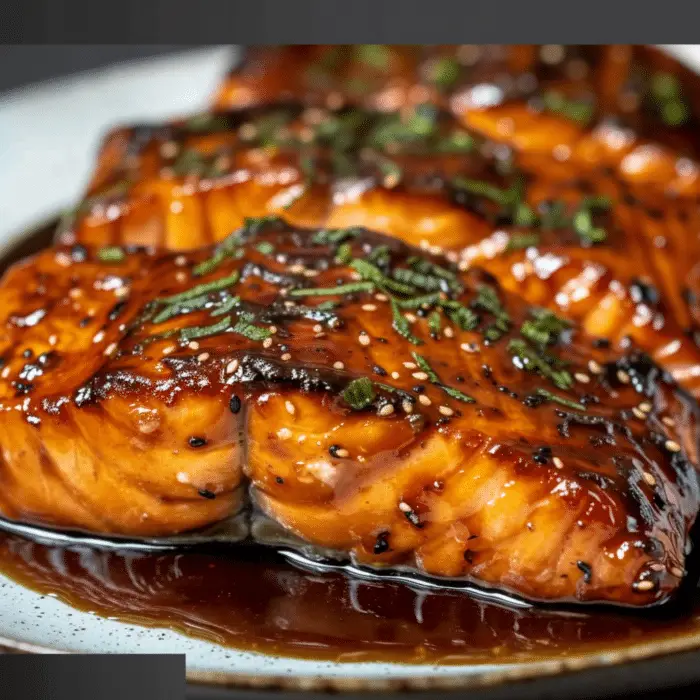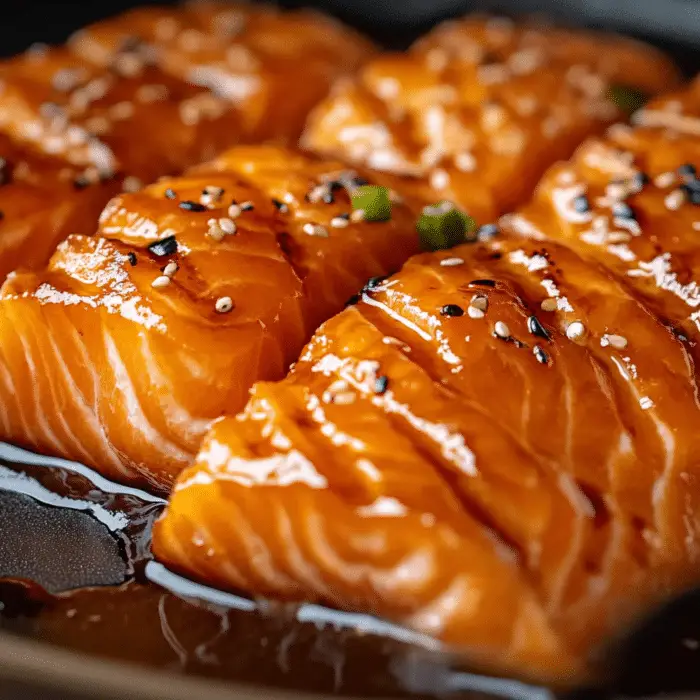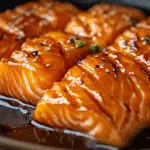If you’re craving a delicious and healthy meal that’s both quick and easy to prepare, this Salmon Teriyaki recipe is the perfect choice. With just a few simple ingredients and minimal prep time, you can create a flavorful dish that will impress anyone at the table. The savory teriyaki sauce pairs wonderfully with tender salmon, making it an ideal weeknight dinner or special meal for any occasion.

Ingredients
For this recipe, gather the following ingredients:
- 500 grams Salmon (skin on)
- 5 tablespoons LIGHT Soy Sauce
- 3 tablespoons Apple Cider Vinegar
- 4 tablespoons Honey
- 1 teaspoon Sesame oil
- 3 cloves Grated Garlic
- Small thumb Grated Ginger
- 1 teaspoon Salt
- 1 teaspoon Fresh Black Pepper
Instructions
- Prepare the Teriyaki Sauce: In a bowl, combine the light soy sauce, apple cider vinegar, honey, sesame oil, grated garlic, grated ginger, salt, and fresh black pepper. Stir well to mix everything together and create the teriyaki sauce.
- Marinate the Salmon: Place the salmon fillets in a shallow dish or ziplock bag. Pour half of the teriyaki sauce over the salmon, making sure all sides are coated. Reserve the remaining sauce for later use. Let the salmon marinate in the refrigerator for at least 30 minutes, or up to overnight for more intense flavor.
- Preheat Your Cooking Surface: Preheat your grill or non-stick skillet over medium-high heat. If using a grill, lightly oil the grates to prevent sticking.
- Cook the Salmon:
- Grill Method: Place the salmon fillets, skin side down, on the grill. Cook for about 4-5 minutes, then carefully flip the fillets. Continue cooking for another 4-5 minutes until the salmon is fully cooked and flakes easily with a fork.
- Skillet Method: Heat a small amount of oil in the skillet over medium-high heat. Add the salmon fillets, skin side down, and cook for 4-5 minutes. Flip the fillets and cook for another 4-5 minutes until the salmon is done and flakes easily.
- Heat the Teriyaki Sauce: While the salmon is cooking, place the reserved teriyaki sauce in a small saucepan. Heat it over medium heat until it thickens slightly.
- Serve: Once the salmon is cooked, remove it from the grill or skillet. Drizzle the thickened teriyaki sauce over the salmon and serve hot with steamed rice or your favorite side dishes.

Serving and Storage Tips
Serving Tips:
- Pair with Rice: Salmon Teriyaki pairs perfectly with steamed white rice, brown rice, or even quinoa. The rice helps absorb the rich teriyaki sauce and complements the flavors of the salmon.
- Add Vegetables: Serve the dish with sautéed or steamed vegetables like broccoli, asparagus, or green beans for a well-rounded, nutritious meal. You can also add a side salad for a fresh contrast to the rich salmon.
- Garnish: Garnish the Salmon Teriyaki with sesame seeds, sliced green onions, or a drizzle of extra teriyaki sauce for added flavor and a beautiful presentation.
- Serve with Noodles: For a different twist, serve the salmon over soba or udon noodles, which pair wonderfully with the teriyaki sauce.
Storage Tips:
- Refrigeration: Store any leftover Salmon Teriyaki in an airtight container in the refrigerator for up to 2-3 days. Make sure the salmon has cooled completely before storing it to maintain its texture.
- Freezing: While it’s best to eat the dish fresh, you can freeze the salmon (without the sauce) for up to 1-2 months. To do so, wrap the cooked salmon fillets tightly in plastic wrap or aluminum foil, and place them in a freezer-safe bag. When ready to eat, thaw in the refrigerator and reheat in a skillet or microwave.
- Reheating: Reheat the leftover salmon in a non-stick skillet over low to medium heat, adding a little extra sauce to keep it moist. Alternatively, you can microwave it in short intervals, ensuring it doesn’t dry out.
By following these serving and storage tips, you can enjoy your Salmon Teriyaki leftovers and keep them tasting fresh!
Variations
While the classic Salmon Teriyaki is delicious on its own, there are plenty of ways to customize the recipe to suit different tastes or dietary preferences. Here are some variations to try:
- Spicy Salmon Teriyaki: For a spicy kick, add 1-2 teaspoons of sriracha sauce or red pepper flakes to the teriyaki sauce. You can also drizzle a bit of chili oil on the cooked salmon for extra heat.
- Citrus-Infused Teriyaki: Add some zest to your teriyaki sauce by incorporating citrus flavors. Mix in the juice and zest of one orange, lemon, or lime to give the dish a refreshing and tangy twist.
- Honey Mustard Salmon Teriyaki: Combine honey with Dijon mustard in the teriyaki sauce to create a tangy-sweet variation. This adds an extra layer of flavor that pairs beautifully with the rich taste of the salmon.
- Grilled Salmon Teriyaki with Pineapple: For a tropical twist, add grilled pineapple slices to the dish. The sweet and smoky pineapple complements the teriyaki sauce perfectly, offering a burst of flavor.
- Teriyaki Salmon with Sesame Crust: For an extra crunchy texture, coat the salmon fillets in toasted sesame seeds before grilling or pan-frying. The sesame seeds add flavor and a delightful crunch to the tender salmon.
- Vegetarian or Vegan Teriyaki: Swap the salmon with tofu or tempeh for a plant-based version of this dish. Marinate and cook the tofu or tempeh the same way as the salmon to enjoy a vegetarian or vegan alternative.
- Sweet and Sour Teriyaki: Add a tablespoon of rice vinegar or a splash of pineapple juice to the sauce to give it a sweet and sour twist, balancing out the savory elements of the teriyaki.
- Teriyaki Salmon with Vegetables: Add vegetables like bell peppers, onions, or zucchini to the pan or grill alongside the salmon. These vegetables soak up the teriyaki sauce and add extra color and texture to the dish.
By experimenting with these variations, you can tailor the Salmon Teriyaki recipe to suit different flavor profiles and dietary preferences, making it even more versatile!
FAQs
- Can I use frozen salmon for this recipe? Yes, you can use frozen salmon. Just be sure to fully thaw it before cooking to ensure even cooking and proper texture.
- How long should I marinate the salmon for the best flavor? Marinate the salmon for at least 30 minutes, but if you have more time, marinating overnight will allow the flavors to penetrate the fish more deeply.
- Can I make the teriyaki sauce ahead of time? Yes, you can prepare the teriyaki sauce in advance. Store it in an airtight container in the fridge for up to a week. This allows the flavors to meld together for an even better taste.
- Can I use a non-stick skillet instead of a grill? Yes, a non-stick skillet works perfectly for cooking the salmon. Just heat it over medium-high heat and follow the same instructions for cooking the salmon.
- Can I substitute the honey with something else? Yes, you can substitute honey with maple syrup, agave nectar, or brown sugar for a different sweetness. Keep in mind that each substitute will slightly change the flavor profile.
- How do I know when the salmon is done cooking? The salmon is done when it easily flakes with a fork and the internal temperature reaches 145°F (63°C). If you don’t have a thermometer, check for flakiness to ensure it’s fully cooked.
- Can I use skinless salmon fillets for this recipe? While the skin adds flavor and helps to hold the salmon together while cooking, you can certainly use skinless fillets if you prefer.
- Can I use this teriyaki sauce for other proteins? Absolutely! This teriyaki sauce is great for other proteins such as chicken, shrimp, or tofu. Just adjust the cooking time according to the protein you’re using.
- How should I store leftover salmon teriyaki? Store leftover salmon teriyaki in an airtight container in the refrigerator for up to 2-3 days. Make sure the salmon has cooled before refrigerating to keep it fresh.
- Can I grill the salmon with the teriyaki sauce already on it? Yes, but be mindful that the sugars in the teriyaki sauce can burn quickly on the grill. It’s best to reserve some sauce for drizzling over the cooked salmon rather than grilling with it directly.
These FAQs should help clarify any questions you may have about making the perfect Salmon Teriyaki!
This Quick and EASY Salmon Teriyaki recipe is a fantastic choice for anyone looking for a flavorful yet simple meal. With just a few ingredients and a short cooking time, you can enjoy a healthy and delicious dish that’s sure to please. Whether you’re cooking for yourself or for a family dinner, this recipe is sure to become a go-to favorite. Enjoy!
Print
Salmon Teriyaki
Description
If you’re craving a delicious and healthy meal that’s both quick and easy to prepare, this Salmon Teriyaki recipe is the perfect choice. With just a few simple ingredients and minimal prep time, you can create a flavorful dish that will impress anyone at the table. The savory teriyaki sauce pairs wonderfully with tender salmon, making it an ideal weeknight dinner or special meal for any occasion.
Ingredients
For this recipe, gather the following ingredients:
- 500 grams Salmon (skin on)
- 5 tablespoons LIGHT Soy Sauce
- 3 tablespoons Apple Cider Vinegar
- 4 tablespoons Honey
- 1 teaspoon Sesame oil
- 3 cloves Grated Garlic
- Small thumb Grated Ginger
- 1 teaspoon Salt
- 1 teaspoon Fresh Black Pepper
Instructions
- Prepare the Teriyaki Sauce: In a bowl, combine the light soy sauce, apple cider vinegar, honey, sesame oil, grated garlic, grated ginger, salt, and fresh black pepper. Stir well to mix everything together and create the teriyaki sauce.
- Marinate the Salmon: Place the salmon fillets in a shallow dish or ziplock bag. Pour half of the teriyaki sauce over the salmon, making sure all sides are coated. Reserve the remaining sauce for later use. Let the salmon marinate in the refrigerator for at least 30 minutes, or up to overnight for more intense flavor.
- Preheat Your Cooking Surface: Preheat your grill or non-stick skillet over medium-high heat. If using a grill, lightly oil the grates to prevent sticking.
- Cook the Salmon:
- Grill Method: Place the salmon fillets, skin side down, on the grill. Cook for about 4-5 minutes, then carefully flip the fillets. Continue cooking for another 4-5 minutes until the salmon is fully cooked and flakes easily with a fork.
- Skillet Method: Heat a small amount of oil in the skillet over medium-high heat. Add the salmon fillets, skin side down, and cook for 4-5 minutes. Flip the fillets and cook for another 4-5 minutes until the salmon is done and flakes easily.
- Heat the Teriyaki Sauce: While the salmon is cooking, place the reserved teriyaki sauce in a small saucepan. Heat it over medium heat until it thickens slightly.
- Serve: Once the salmon is cooked, remove it from the grill or skillet. Drizzle the thickened teriyaki sauce over the salmon and serve hot with steamed rice or your favorite side dishes.
Notes
Serving Tips:
- Pair with Rice: Salmon Teriyaki pairs perfectly with steamed white rice, brown rice, or even quinoa. The rice helps absorb the rich teriyaki sauce and complements the flavors of the salmon.
- Add Vegetables: Serve the dish with sautéed or steamed vegetables like broccoli, asparagus, or green beans for a well-rounded, nutritious meal. You can also add a side salad for a fresh contrast to the rich salmon.
- Garnish: Garnish the Salmon Teriyaki with sesame seeds, sliced green onions, or a drizzle of extra teriyaki sauce for added flavor and a beautiful presentation.
- Serve with Noodles: For a different twist, serve the salmon over soba or udon noodles, which pair wonderfully with the teriyaki sauce.
Storage Tips:
- Refrigeration: Store any leftover Salmon Teriyaki in an airtight container in the refrigerator for up to 2-3 days. Make sure the salmon has cooled completely before storing it to maintain its texture.
- Freezing: While it’s best to eat the dish fresh, you can freeze the salmon (without the sauce) for up to 1-2 months. To do so, wrap the cooked salmon fillets tightly in plastic wrap or aluminum foil, and place them in a freezer-safe bag. When ready to eat, thaw in the refrigerator and reheat in a skillet or microwave.
- Reheating: Reheat the leftover salmon in a non-stick skillet over low to medium heat, adding a little extra sauce to keep it moist. Alternatively, you can microwave it in short intervals, ensuring it doesn’t dry out.
